BC BEFORE CLOVIS
UPDATED
Incredible Fossil Footprints Are The Earliest Known Trace of Humans in North America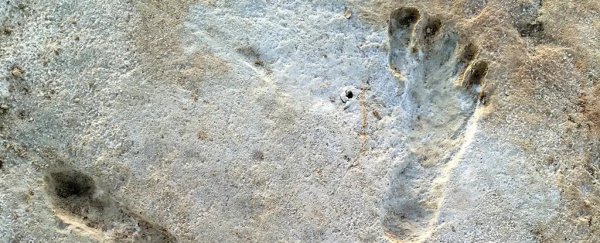
Some of the fossil footprints discovered in White Sands National Park.
(Reynolds et al., Science, 2021)
AYLIN WOODWARD, BUSINESS INSIDER
24 SEPTEMBER 2021
A new discovery offers definitive evidence that humans were in North America far earlier than archaeologists previously thought – a whopping 7,000 years earlier.
Fossil footprints found on the shore of an ancient lake bed in New Mexico's White Sands National Park date as far back as 23,000 years ago, making them the oldest ever found in North America.
That timing means humans occupied southern parts of the continent during the peak of the final ice age, which upends our previous understanding of when and how they moved south.
The previous idea was that the first people to occupy North America crossed a land bridge that existed between modern-day Siberia and Alaska during the last ice age, between 26,500 and 19,000 years ago.
According to that theory, they would have had to settle near the Arctic because ice sheets covering Canada made it impossible for them to go south.
Then later, once these glaciers melted between 16,000 and 13,500 years ago, the migration toward South America began.
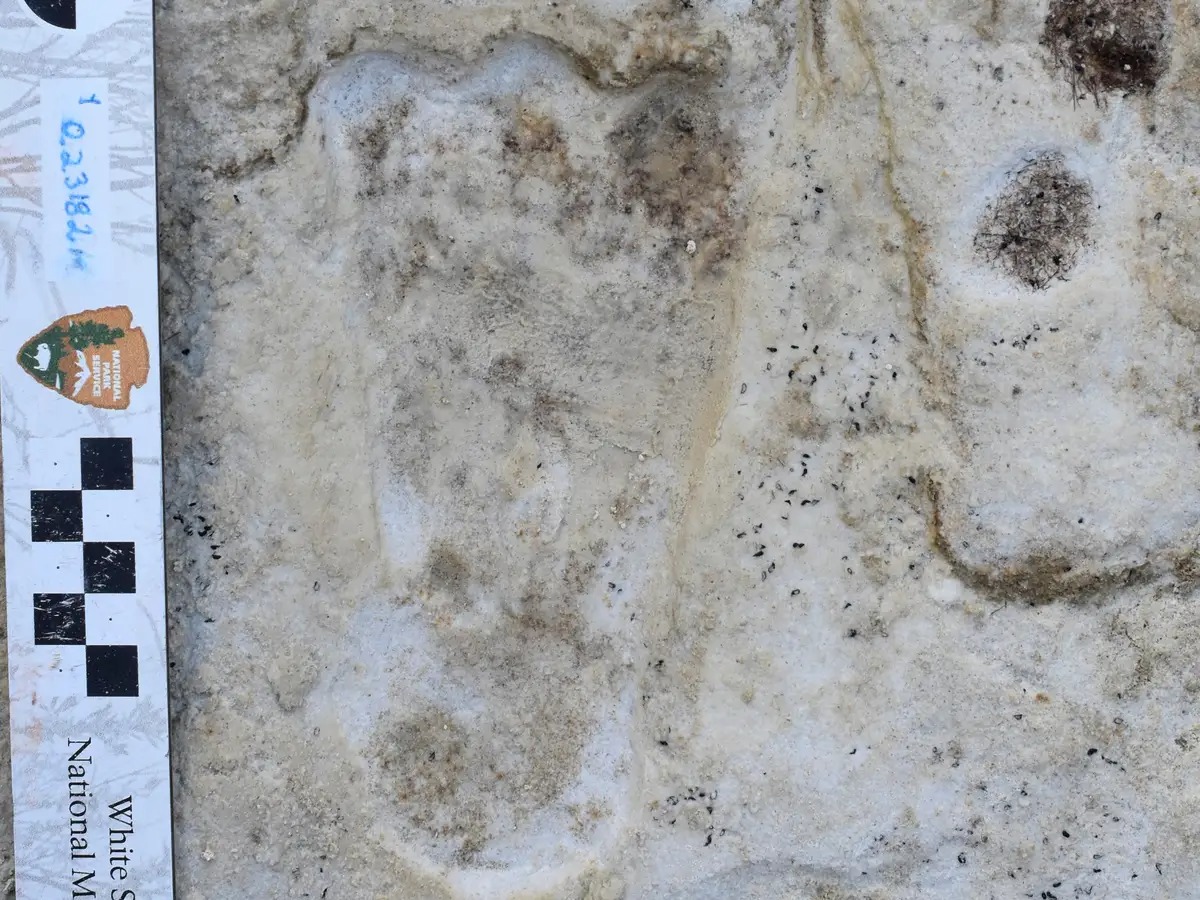
New Mexico footprints show humans walked in North America some 23,000 years ago
Scientists manage to date seeds discovered in fossilized prints, giving a more definitive time frame to question of when people first arrived in Americas
By AGENCIEST
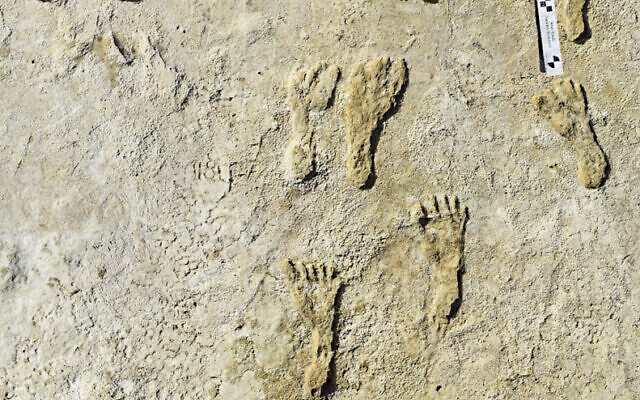
This undated photo made available by the National Park Service in September 2021 shows fossilized human footprints at the White Sands National Park in New Mexico.
“What we present here is evidence of a firm time and location,” they said.
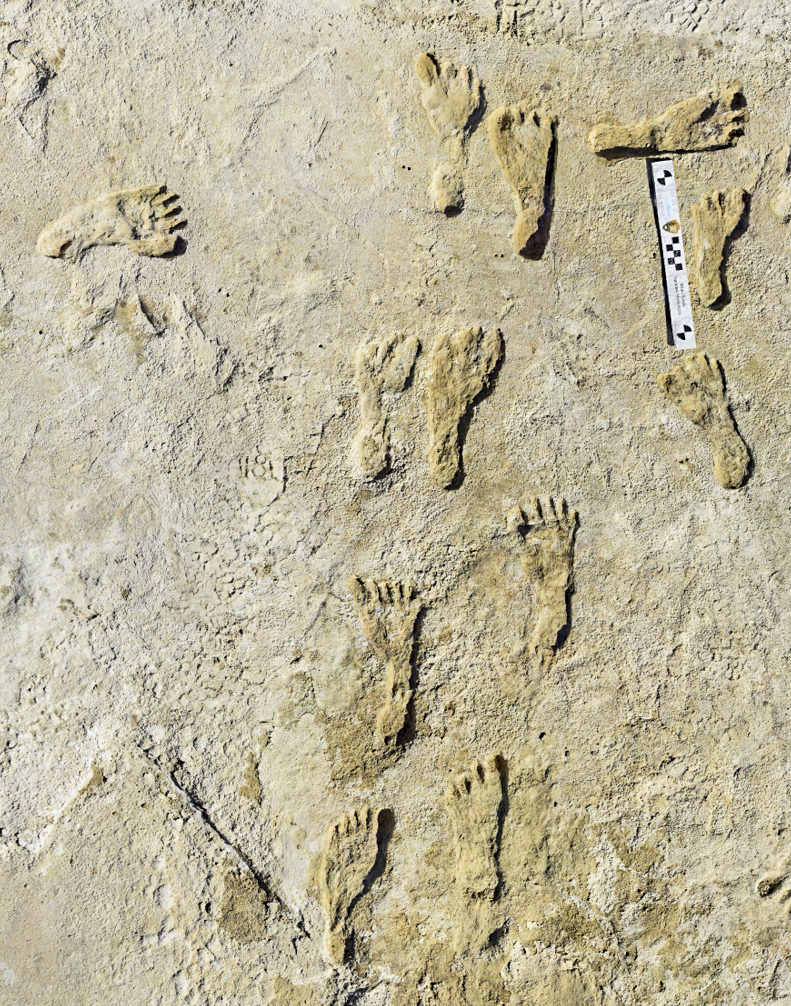
This undated photo made available by the National Park Service in September 2021 shows fossilized human fossilized footprints at the White Sands National Park in New Mexico. According to a report published in the journal Science on Thursday, Sept. 23, 2021, the impressions indicate that early humans were walking across North America around 23,000 years ago, much earlier than scientists previously thought. (NPS via AP)
The footprints were left in mud on the banks of a long-since dried up lake, which is now part of a New Mexico desert.
Sediment filled the indentations and hardened into rock, protecting evidence of our ancient relatives, and giving scientists a detailed insight into their lives.
Based on the size of the footprints, researchers believe that at least some were made by children and teenagers who lived during the last ice age.
“Many tracks appear to be those of teenagers and children; large adult footprints are less frequent,” write the authors of the study.
“One hypothesis for this is the division of labor, in which adults are involved in skilled tasks whereas ‘fetching and carrying’ are delegated to teenagers.
“Children accompany the teenagers, and collectively they leave a higher number of footprints.”
David Bustos, the park’s resource program manager, spotted the first footprints in ancient wetlands in 2009. He and others found more in the park over the years.
“We knew they were old, but we had no way to date the prints before we discovered some with (seeds) on top,” he said Thursday.
Made of fine silt and clay, the footprints are fragile, so the researchers had to work quickly to gather samples, Bustos said.
“The only way we can save them is to record them — to take a lot of photos and make 3D models,” he said.
Earlier excavations in White Sands National Park have uncovered fossilized tracks left by a saber-toothed cat, dire wolf, Columbian mammoth and other ice age animals.
AYLIN WOODWARD, BUSINESS INSIDER
24 SEPTEMBER 2021
A new discovery offers definitive evidence that humans were in North America far earlier than archaeologists previously thought – a whopping 7,000 years earlier.
Fossil footprints found on the shore of an ancient lake bed in New Mexico's White Sands National Park date as far back as 23,000 years ago, making them the oldest ever found in North America.
That timing means humans occupied southern parts of the continent during the peak of the final ice age, which upends our previous understanding of when and how they moved south.
The previous idea was that the first people to occupy North America crossed a land bridge that existed between modern-day Siberia and Alaska during the last ice age, between 26,500 and 19,000 years ago.
According to that theory, they would have had to settle near the Arctic because ice sheets covering Canada made it impossible for them to go south.
Then later, once these glaciers melted between 16,000 and 13,500 years ago, the migration toward South America began.

One of the footprints. (Reynolds et al., Science, 2021)
This new finding, however, "definitively places humans in North America at time when the ice sheet curtains were very firmly closed," Sally Reynolds, a paleoecologist at Bournemouth University in England and co-author of the new study, told Insider.
So most likely, Reynolds said, humans migrated south in multiple waves, and one of those was before the last ice age. Those early people may have even sailed down the Pacific coast.
"Then more came down after the ice receded," Reynolds said.
The finding was published Thursday in the journal Science, and the study also describes nearby tracks found from mammoths, dire wolves, and giant ground sloths – prey for ancient humans.
The oldest known footprints in the Americas
Reynolds' team found 60 human footprints between 21,000 and 23,000 years old. The researchers estimated the tracks' age by dating microscopic seeds from an aquatic plant found in layers of lake sediment that sandwiched the prints.
"It's unequivocal evidence," Reynolds said. "The layers go seeds, footprints, seeds."
The footprints are now the oldest in the Americas, taking over from a 15,600-year-old footprint found in Chile a decade ago.
Most of the tracks belonged to teenagers and children, the team found, possibly indicating the youngsters played in the area while adults hunted and gathered.
Reynolds said that before this finding, the earliest estimate as to when humans started occupying North America was 16,000 years ago.
The only clue that people might have arrived earlier is a set of stone tools and artifacts found in remote Mexican cave. Archaeologists estimated that sediment ensconcing those artifacts was 32,000 years old, but that's not a trustworthy measure, Reynolds said. Artifacts can migrate up and down through sediment layers over time.
"Footprints, by contrast, are fixed on the landscape," Reynolds said.
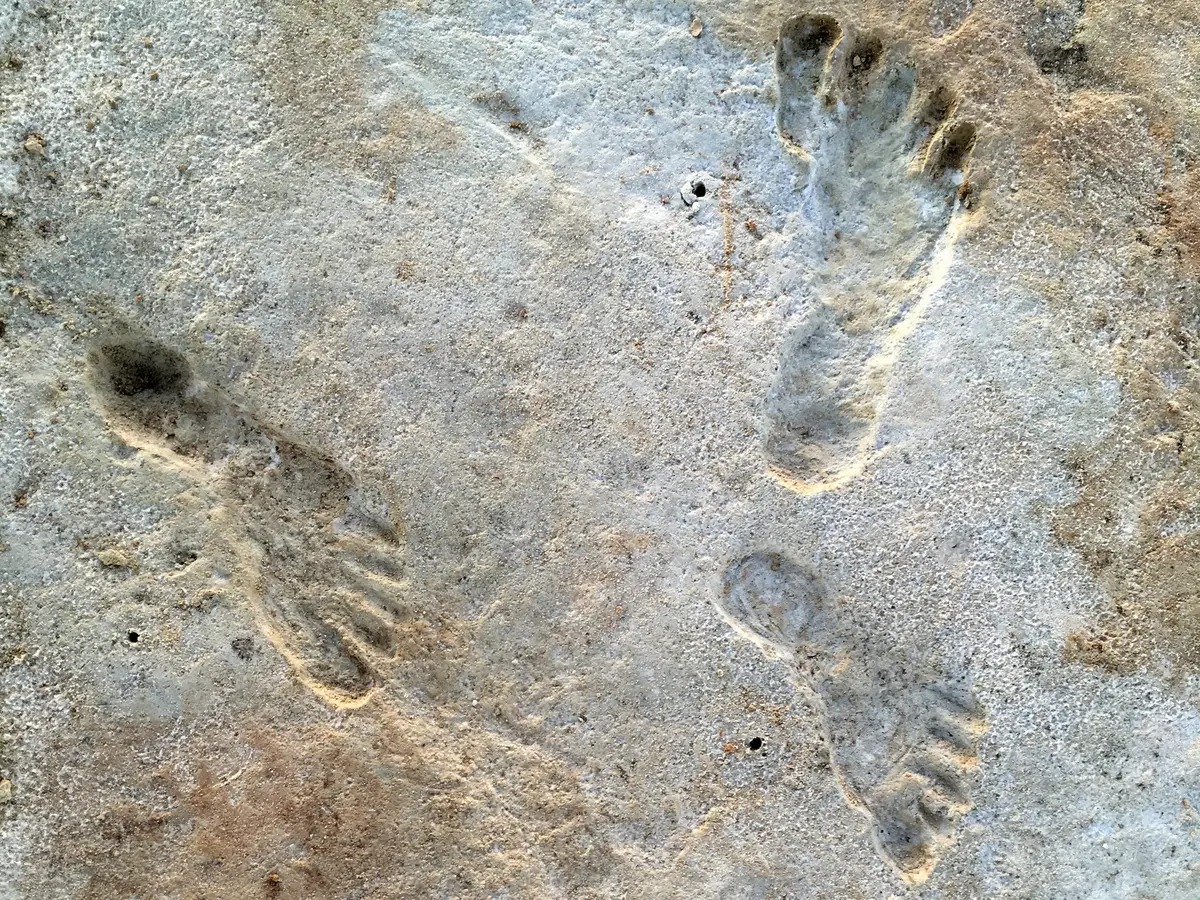
Some of the fossil footprints discovered in White Sands National Park. (Reynolds et al., Science, 2021)
This new finding, however, "definitively places humans in North America at time when the ice sheet curtains were very firmly closed," Sally Reynolds, a paleoecologist at Bournemouth University in England and co-author of the new study, told Insider.
So most likely, Reynolds said, humans migrated south in multiple waves, and one of those was before the last ice age. Those early people may have even sailed down the Pacific coast.
"Then more came down after the ice receded," Reynolds said.
The finding was published Thursday in the journal Science, and the study also describes nearby tracks found from mammoths, dire wolves, and giant ground sloths – prey for ancient humans.
The oldest known footprints in the Americas
Reynolds' team found 60 human footprints between 21,000 and 23,000 years old. The researchers estimated the tracks' age by dating microscopic seeds from an aquatic plant found in layers of lake sediment that sandwiched the prints.
"It's unequivocal evidence," Reynolds said. "The layers go seeds, footprints, seeds."
The footprints are now the oldest in the Americas, taking over from a 15,600-year-old footprint found in Chile a decade ago.
Most of the tracks belonged to teenagers and children, the team found, possibly indicating the youngsters played in the area while adults hunted and gathered.
Reynolds said that before this finding, the earliest estimate as to when humans started occupying North America was 16,000 years ago.
The only clue that people might have arrived earlier is a set of stone tools and artifacts found in remote Mexican cave. Archaeologists estimated that sediment ensconcing those artifacts was 32,000 years old, but that's not a trustworthy measure, Reynolds said. Artifacts can migrate up and down through sediment layers over time.
"Footprints, by contrast, are fixed on the landscape," Reynolds said.

Some of the fossil footprints discovered in White Sands National Park. (Reynolds et al., Science, 2021)
Humans could have traveled south by boat
Reynolds said it's not yet clear how, exactly, humans traveled to the White Sands site – though there are several leading theories.
One suggests they traveled down the west coast via an ice-free corridor of land. Another proposes that they came by boat, possibly sailing from modern-day Russia or Japan and then expanding south by hugging the Pacific Coast.
Reynolds said she also thinks it's possible our ancestors might have crossed the continent then sailed down the Atlantic coast, before trekking to New Mexico.
"There's this hovering question mark over the role of their seafaring skills," she said.
Ancient humans in North America hunted giant sloths
This isn't the first remarkable discovery to come from the White Sands site.
"Its value goes far, far beyond the date of these new footprints," Reynolds said.
Three years ago, her team uncovered a different set of human and animal tracks at the site dating back to about 15,500 years ago. Those footprints revealed an epic battle between predator and prey: A human was stalking a giant sloth.
"The human was walking right behind it," Reynolds said, adding, "and the sloth is absolutely not liking it."
Giant ground sloths went extinct some 12,000 years ago. Around the same time, up to 90 percent of all large-bodied animals in the world, including mastodons, prehistoric horses, and ancient giant armadillos, also went extinct.
Many archaeologists think that early humans in the Americas played an outsized role in that mass extinction there, given that it happened within a few millennia of their arrival.
"Humans show up and megafauna start dying," Reynolds said. "It seems like an obvious cause and effect relationship."
This article was originally published by Business Insider.
Reynolds said it's not yet clear how, exactly, humans traveled to the White Sands site – though there are several leading theories.
One suggests they traveled down the west coast via an ice-free corridor of land. Another proposes that they came by boat, possibly sailing from modern-day Russia or Japan and then expanding south by hugging the Pacific Coast.
Reynolds said she also thinks it's possible our ancestors might have crossed the continent then sailed down the Atlantic coast, before trekking to New Mexico.
"There's this hovering question mark over the role of their seafaring skills," she said.
Ancient humans in North America hunted giant sloths
This isn't the first remarkable discovery to come from the White Sands site.
"Its value goes far, far beyond the date of these new footprints," Reynolds said.
Three years ago, her team uncovered a different set of human and animal tracks at the site dating back to about 15,500 years ago. Those footprints revealed an epic battle between predator and prey: A human was stalking a giant sloth.
"The human was walking right behind it," Reynolds said, adding, "and the sloth is absolutely not liking it."
Giant ground sloths went extinct some 12,000 years ago. Around the same time, up to 90 percent of all large-bodied animals in the world, including mastodons, prehistoric horses, and ancient giant armadillos, also went extinct.
Many archaeologists think that early humans in the Americas played an outsized role in that mass extinction there, given that it happened within a few millennia of their arrival.
"Humans show up and megafauna start dying," Reynolds said. "It seems like an obvious cause and effect relationship."
This article was originally published by Business Insider.
New Mexico footprints show humans walked in North America some 23,000 years ago
Scientists manage to date seeds discovered in fossilized prints, giving a more definitive time frame to question of when people first arrived in Americas
By AGENCIEST

This undated photo made available by the National Park Service in September 2021 shows fossilized human footprints at the White Sands National Park in New Mexico.
(NPS via AP)
Fossilized footprints discovered in New Mexico indicate that early humans were walking across North America around 23,000 years ago, researchers reported Thursday.
The first footprints were found in a dry lake bed in White Sands National Park in 2009. Scientists at the US Geological Survey recently analyzed seeds stuck in the footprints to determine their approximate age, ranging from around 22,800 and 21,130 years ago.
The findings may shed light on a mystery that has long intrigued scientists: When did people first arrive in the Americas, after dispersing from Africa and Asia?
Most scientists believe ancient migration came by way of a now-submerged land bridge that connected Asia to Alaska. Based on various evidence — including stone tools, fossil bones and genetic analysis — other researchers have offered a range of possible dates for human arrival in the Americas, from 13,000 to 26,000 years ago or more.
The current study provides a more solid baseline for when humans definitely were in North America, although they could have arrived even earlier, the authors say. Fossil footprints are more indisputable and direct evidence than “cultural artifacts, modified bones, or other more conventional fossils,” they wrote in the journal Science, which published the study Thursday.
Fossilized footprints discovered in New Mexico indicate that early humans were walking across North America around 23,000 years ago, researchers reported Thursday.
The first footprints were found in a dry lake bed in White Sands National Park in 2009. Scientists at the US Geological Survey recently analyzed seeds stuck in the footprints to determine their approximate age, ranging from around 22,800 and 21,130 years ago.
The findings may shed light on a mystery that has long intrigued scientists: When did people first arrive in the Americas, after dispersing from Africa and Asia?
Most scientists believe ancient migration came by way of a now-submerged land bridge that connected Asia to Alaska. Based on various evidence — including stone tools, fossil bones and genetic analysis — other researchers have offered a range of possible dates for human arrival in the Americas, from 13,000 to 26,000 years ago or more.
The current study provides a more solid baseline for when humans definitely were in North America, although they could have arrived even earlier, the authors say. Fossil footprints are more indisputable and direct evidence than “cultural artifacts, modified bones, or other more conventional fossils,” they wrote in the journal Science, which published the study Thursday.
“What we present here is evidence of a firm time and location,” they said.

This undated photo made available by the National Park Service in September 2021 shows fossilized human fossilized footprints at the White Sands National Park in New Mexico. According to a report published in the journal Science on Thursday, Sept. 23, 2021, the impressions indicate that early humans were walking across North America around 23,000 years ago, much earlier than scientists previously thought. (NPS via AP)
The footprints were left in mud on the banks of a long-since dried up lake, which is now part of a New Mexico desert.
Sediment filled the indentations and hardened into rock, protecting evidence of our ancient relatives, and giving scientists a detailed insight into their lives.
Based on the size of the footprints, researchers believe that at least some were made by children and teenagers who lived during the last ice age.
“Many tracks appear to be those of teenagers and children; large adult footprints are less frequent,” write the authors of the study.
“One hypothesis for this is the division of labor, in which adults are involved in skilled tasks whereas ‘fetching and carrying’ are delegated to teenagers.
“Children accompany the teenagers, and collectively they leave a higher number of footprints.”
David Bustos, the park’s resource program manager, spotted the first footprints in ancient wetlands in 2009. He and others found more in the park over the years.
“We knew they were old, but we had no way to date the prints before we discovered some with (seeds) on top,” he said Thursday.
Made of fine silt and clay, the footprints are fragile, so the researchers had to work quickly to gather samples, Bustos said.
“The only way we can save them is to record them — to take a lot of photos and make 3D models,” he said.
Earlier excavations in White Sands National Park have uncovered fossilized tracks left by a saber-toothed cat, dire wolf, Columbian mammoth and other ice age animals.
No comments:
Post a Comment